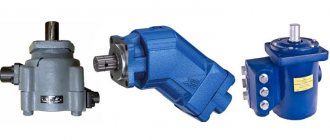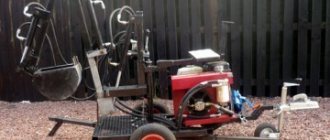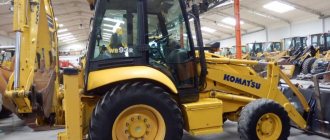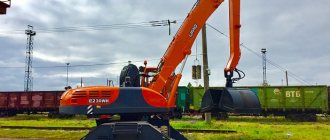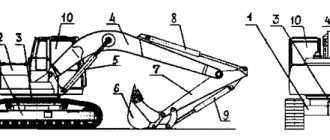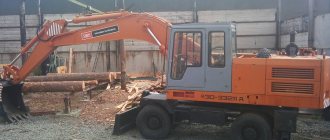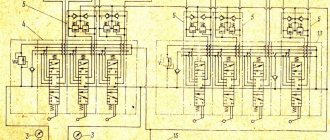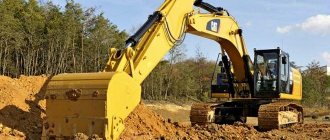Question from a reader of our portal: What does an excavator with a front and back shovel mean?
Answer: These are excavators that have additional equipment installed instead of the classic bucket. It could be:
- Straight shovel . It is used to work with embankments and other soils located above the level of equipment wheels. A straight shovel helps to carefully take sand and other bulk materials and move it to a given place. It can also be used to load and unload materials;
- Backhoe . Helps to rake material towards the excavator. Such special equipment is usually used for digging trenches and holes;
- Grabs . These attachments are commonly used for digging deep trenches and also for underwater work.
- Draglines are a bucket placed on ropes that can be lowered to great depths.
Note that excavators differ from each other not only in the configuration of their equipment and the working volume of the bucket, but also in the dimensions of the equipment and power. They can be either single-bucket or multi-bucket. Also, jackhammers are often attached to excavators, with which you can develop rocky soils or break down buildings, piling rigs, well drilling equipment, etc.
OL device with a composite boom.
OL (Fig. 1) is a set of equipment including:
excavator frame 1, control cabin 2, lower and upper parts of the boom 3 and 4, hydraulic cylinders (h/c) 5, 6, 11, handle 7, lever system 8, bucket 9, link 10, various boom positions 12.
The composite boom consists of: the main lower part 3 and the extending upper part 4, the handle 7, pivotally connected to the part of the boom 4, the bucket 9, using a system of levers suspended on the handle 7 and the c/c 5, 6, 11 of the boom control 3, handle 7 and turning the bucket 9.
The boom elements are box-section metal structures made of rolled sheets. The boom assembly is installed using an axial connection on the rotating frame 1, and the cylinder head 11 is pivotally mounted there, the rod of which, using a fork, is connected to the bottom of the boom 3.
When oil is supplied under pressure into the cavity of the hydraulic unit 11, its rod extends or retracts, thereby rotating the boom assembly in a vertical plane. The handle 7 is pivotally mounted on the end part of the upper part of the boom 4 and can be rotated with the help of the crankcase 5 in the vertical plane.
The bucket 9 is mounted pivotally on the handle 7 and is also rotated using the cylinder head 6. Because the upper and lower parts of the boom are connected by an axis, their rotation relative to each other is limited by link 10.
The boom rotation drive is carried out by g/c 11 using various configurations for its installation: under the boom (1 1), above the boom (1.2), through a double-arm lever (1.3).
Options for installing the handle and bucket drive are shown in Fig. 1.4, 1.5 and 1.6. Sometimes, the boom rotation drive and the handle rotation drive are carried out in pairs 11.
The handle drive 7, g/c 5 is pivotally mounted on the top of the boom 4, and the bucket rotation drive 9 g/c 6 is pivotally mounted on the handle, and its rod, through a system of levers 8, is connected to the bucket 9, rotating it in a vertical plane, as shown in Fig. 1 pos. 4, 5, and 6.
Straight shovel:
Purpose of a straight shovel : to loosen, remove, dig soil (layers of earth, rocks, etc.) above the level of the equipment.
The design of a straight shovel is a bucket connected to a handle, which is attached to the boom using hinges. The latter, also of the hinged type, is attached to a rotating platform mounted on a chassis base.
In relation to the type of drive, the movement of the bucket and arm can be:
– movable – tipping of the bucket is provided by cylinders (hydraulic);
– without movable – the material spills out through the opening bottom of the bucket (mechanical).
The number of operations performed in one cycle of a straight shovel is small, and the digging force is the highest among all types of main working equipment, so it is considered the most productive.
The main use of a straight shovel is the development of the earth's subsoil and loading materials into equipment.
The work cycle of a straight shovel includes:
– loading the bucket with material;
– rotation of the platform along a given vector;
– boom lift;
– unloading of material.
Work of OL with a composite boom.
In the initial position, the hydraulic rod 5 is retracted—the handle 7 is raised, the hydraulic rod 11 is extended—the boom assembly is raised, the hydraulic rod 6 is retracted—the bucket 9 is raised. To carry out the working cycle of digging, it is necessary to retract the rod 11, extend the rods 5 and 6, for which oil is supplied to the corresponding cavities of the cylinder, the bucket touches the ground with its teeth, is inserted into it with the force of the cylinder and is filled .
To unload the bucket, the operations are performed in the reverse order and, after unloading the soil, the cycle is repeated. To reduce the time of the entire cycle, some operations are combined, which depends on the experience and skill of the excavator operator and helps to increase productivity.
Backhoe:
The backhoe has found its application in soil development work below the equipment level. The exception is hydraulically driven excavators, which carry out work above the development horizon, but their productivity is lower than that of a straight shovel. The bucket is moved in the direction of the machine.
Main tasks of a backhoe :
– digging holes, trenches, pits;
– slope planning;
- filling of embankments.
Each type of backhoe has its own operating cycle.
Operating cycle of hydraulic excavator with independent boom drive:
– the boom is lowered into the recess, while at the same time the handle is installed in the desired position;
– the bucket is filled by rotating relative to the handle;
– the boom rises synchronously with the turn of the handle and the turn of the shovel to avoid soil spillage;
– the working platform makes a turn; The bucket is unloaded by turning it relative to the handle.
Mechanical excavators with a two-rope drive, a fixed position of the shovel and a dependent position of the boom, perform the work cycle as follows:
– releasing the crane brake allows the boom to be lowered;
– the resulting resistance of the rope ensures that the bucket is loaded by turning the handle relative to the boom in the direction of the equipment;
– the boom rises;
– the turntable rotates;
– the tension of the lifting and parallel unwinding of the traction ropes lead to the unloading of materials by turning the handle relative to the boom in the direction from the excavator.
A backhoe is considered a multifunctional type of work equipment. It allows you to accurately fix the bucket relative to a selected point of both the surface being developed and the truck where the soil is placed.
OL device with a monoblock boom.
OL (Fig. 2) is a complex of equipment including: hydraulic boom, handle and bucket 1, 5, 9; piping layout 2, monoblock boom 3, handle 4, lever system 6, rod 7, bucket 8, excavator platform 10, hinge axes 11, 12, 16 and 17, pins 13, 15, brackets 14.
A monoblock boom is a curved box beam welded from sheet metal. The handle is also a box-section metal structure welded from rolled sheets. The boom is hinged to the rotating platform of the excavator, and the handle is attached to it using an axle. The bucket is mounted on the handle using an axle.
The rotation of the boom, arm and bucket is carried out by hydraulic cylinders, hinged on these components.
Depending on the quality of the soil, OLs are equipped with buckets of various sizes and designs. The bucket is a welded-cast container with an open upper wall, equipped with replaceable teeth fixed to the lower working surface.
The cutting edge of the bucket is equipped with a hard-to-wear surface, and the teeth are made of high-manganese steel to prevent wear. The teeth and sockets for their installation are made in such a way as to facilitate their installation and replacement.
Other features of excavators
In general, excavators are universal equipment. This is due to the fact that they have a movable working body that moves separately from the chassis and can be used in almost any way. This special equipment can be additionally equipped with a blade or loader, which allows you to work with loose soils or building materials.
Such versatility of these machines has led to the fact that today not a single construction site can be completed without an excavator. With its help, you can excavate soil, make embankments, load bulk materials, and mine mineral resources. These devices are used for digging trenches and pits, uprooting trees and stumps, dismantling old buildings, dismantling metal structures, creating dams, etc.
Excavators are produced both on wheeled and tracked bases. Wheeled models are distinguished by good cross-country ability and maneuverability; they can move on general roads and work in dense urban areas. Tracked models are characterized by high power and maneuverability: they can move over embankments, marshy soils, sand and other unstable soils. However, this special equipment cannot be used on asphalt; if the construction site is far away, it will have to be transported on special trucks.
Work of OL with a monoblock boom.
In the initial position, the hydraulic rod 9 is extended, the hydraulic rods 1 and 5 are retracted, the boom 3 is in the raised position, the handle 4 is raised, the bucket 8 is in the raised position. When the working fluid is supplied to the corresponding cavities of the c/c, the bucket teeth lie on the ground and, with the force developed by all c/c, are embedded into it.
After filling the bucket, the work of all hydraulic units is carried out in the reverse order and, after turning the boom fixed on the turntable of the excavator and installing it above the unloading point, the bucket, turning, is unloaded.
Grab bucket (grab):
A grab bucket (grab) is a lifting device used for digging narrow and deep trenches, loading and unloading materials.
The excavator drive can be anything, but the grab has its own characteristics:
– hydraulic – additionally there is a jaw drive, and the grab itself is attached to the handle, replacing the bucket;
– mechanical – involves a rope suspension.
If necessary, hydraulic excavators can use a telescopic boom instead of a handle, which allows the grab down to a distance of up to 6 m.
Choosing a bucket depending on the soil
Based on the type of soil that an excavator bucket can work with, there are three subgroups:
- Standard. Works with a variety of soils including clay, gravel and sand. They are made from high-quality wear-resistant steel grade 09G2Sb 10HSND with a hardness rating of HB200-250.
- Reinforced. They are necessary for working with abrasive materials in difficult conditions for earthworks. Models are produced from wear-resistant steel with additional welded protection - linings made of Hardox steel and similar ones.
- Rocky. Special buckets for working with rock and hard rocks. They have inter-tooth protection, a thickened bottom, and protected linings on the cheeks and side walls. All auxiliary elements affect the service life of the equipment.
In urban conditions, at ordinary construction sites, excavators with standard buckets of different subtypes are most often found. Reinforced and rock options are used only for certain types of work.
Doosan
Doosan Infracore is the only manufacturer in the world that has launched serial production of crawler excavators equipped with a straight shovel with a bucket, with a volume of 2.16 to 3.5 m. The characteristics are described in more detail in the table.
Table 5. Technical characteristics of Doosan straight shovel excavators.
| Model | Weight, t | Bucket capacity, m3 | Model / Engine power, (kW) | Unloading height, m | Max. boom radius, m | Max. scooping height, m | Bucket design features |
| S 340LC | 37 | 2,16 | DE-12TIS (184) | 6 | 8,9 | 9 | with unloading and tipping |
| S 340 LC.1 | 37,0 | 2,16 | DE-12TIS (184) | 6,7 | 8,4 | 9 | with bottom loading |
| S 420LC | 46,0 | 2,6 | DE-12TIS (210) | 6,3 | 9,5 | 9,8 | with unloading and tipping |
| S 420 LC.1 | 46,0 | 2,6 | DE-12TIS (210) | 7 | 9 | 9,8 | with bottom unloading |
| S 470/ 500 LC | 55,0 | 3,5 | DE-12TIS (245) | 7,2 | 10 | 10,5 | with unloading and tipping |
| S 470/ 500LC.1 | 55,0 | 3,5 | DE-12TIS (245) | 7,5 | 9,5 | 10,5 | with bottom unloading |
DOOSAN S 470 LC
The company's innovative development is in great demand on the market - a crawler excavator equipped with a Doosan S 500LC-V SFS straight shovel.
It allows excavation at significant depths.
Hitachi
Hitachi Construction Machinery Co are the patriarchs of the excavator industry. Hydroficated excavators, which have supplanted their predecessors, are their development. These excavators rightfully occupy a leading position in sales in the Russian Federation. They are superior to similar models from European manufacturers. All thanks to the dynamism of the company. After all, it sensitively and accurately responds to current market demands.
The operational and technical characteristics of Japanese excavators are significantly superior to those of European manufacturers in terms of build quality, functionality and reliability.
Table 6. Technical characteristics of Hitachi excavators
| Model | Weight, t | Bucket capacity, m3 | Model/Motor power, (kW) | Unloading height, m | Design features | |||
| Max. boom radius, m | Max. bucket opening/width, mm | Max. scooping height, m | Handle pressure force, kN | |||||
| Hitachi ZX450-3 | 47,2 | 2,6 | Isuzu AH-6WG1XYSA-01 (260) | 7,5 | 8,76 | 1390 | 10 | 293 |
| Hitachi ZX 470H | 48,1 | 2,3 | Isuzu AH-6WG1XYSA-01 (260) | 7,5 | 8,76 | 1390 | 10 | 293 |
| Hitachi ZX 850-3 | 81,7 | 4,0 | Isuzu AH-6WG1XYSA-03 (397) | 7,91 | 10 | 1600 | 10,86 | 464 |
| Hitachi ZX 870H-3 | 82,8 | 3,6 | Isuzu AH-6WG1XYSA-03 (397) | 7,91 | 10 | 1600 | 10,86 | 464 |
| Hitachi EX 1200 | 111 | 6,3 | Cummins QSK23 (567) | 8,74 | 11,44 | 1880/ 2700 | 12,35 | Horizontal pressure distance, mm-4340 |
| Hitachi EX 1900 | 191 | 11 | Cummins QSK38-C (810) | 10,44 | 13,44 | 2100/ 3260 | 14,61 | Horizontal pressure distance, mm-4820 |
| Hitachi EX 2500 | 248 | 15 | Cummins QSK50-С (1044) | 10,35 | 14,3 | 2150/ 3590 | 15,25 | Horizontal pressure distance, mm-4980 |
| Hitachi EX 3600 | 361 | 22 | Cummins QSK60-C (1450) | 10,99 | 15,22 | 1950/4160 | 6,31 | Horizontal pressure distance, mm-5050 |
| Hitachi EX 5500 | 518 | 27 | Cummins QSK50Сх2 (1044х2 | 13,1 | 16,6 | 2700/4700 | 18,9 | Horizontal pressure distance, mm-5550 |
Hitachi ZX850-3
Hitachi is the world's fifth largest manufacturer of construction earthmoving equipment. The keys to success include operator comfort, enhanced excavator capabilities and simplified maintenance.
Caterpillar
The American company Caterpillar supplies wheeled and crawler excavators to the special equipment market.
The manufacturer specializes in the production of excavators of various sizes:
- mini;
- small class;
- middle class;
- large class.
Models with a straight shovel are designed for mining rocks above the parking level. They combine mainly compact-sized equipment.
Production of front shovel excavators is declining worldwide. Their place is taken by universal machines that combine an excavator and a bucket - that is, they have a backhoe and a front-end loader.
Table 4. Caterpillar Front Shovel Excavator Specifications
| Model | Weight, t | Bucket capacity, m3 | Model/Motor power, (kW) | Unloading height, m | Maximum boom reach, m | Excavation depth, m |
| Caterpillar 5090B | 83,8 | 5,2 | Caterpillar 3406С (319) | 8,2 | 10,2 | 2,8 |
| Caterpillar 5130B | 181 | 9-11 | Caterpillar 3508B (597) | 10 | 12,5 | 3,1 |
Caterpillar 5090B
The bucket capacity of straight shovel excavators is usually more than 4 m3. They are mainly used in rock and ore mining.
Strug:
A plow is a type of equipment designed for layer-by-layer cutting of soil, loading it into trucks or dumping it.
Plows are used to perform terrain leveling tasks.
plow design includes a boom and a rope with a cart moving along it, at the end of which a bucket is attached. When rearranging the bucket relative to the cart, it becomes possible to change the direction of cutting the layers.
Komatsu
The Japanese company Komatsu is a world leader in the production of various construction equipment. Wheeled and tracked excavators from this manufacturer are available on the market. Komatsu mini excavators stand out separately.
Crawler excavators are characterized by low pressure on the soil and high maneuverability. This advantage allows them to be used in places inaccessible to wheeled vehicles, as well as in swampy areas and on soft soils. Detailed technical characteristics and features are presented in the table.
Table 1. Komatsu crawler excavators
| Excavator model | Operating weight, t | Bucket capacity (SAE), m? | Engine power, (kW) | Unloading height | Flywheel power, kW/hp. | Maximum boom reach | Excavation depth, m |
| Komatsu PC600 | 57 | 3,7 | 294 | 8,2 | 125 / 168 | 10 | 3,4 |
| Komatsu PC750 | 76 | 4,5 | 334 | 8,1 | 338/454 | 10,1 | 3,2 |
| Komatsu PC1250 | 110 | 6,5 | 479 | 8,7 | 485/651 | 12,7 | 3,5 |
| Komatsu PC1800 | 180 | 11 | 668 | 9,6 | 676/1800 | 13,1 | 3,22 |
| Komatsu PC3000 | 253 | 20 | 926 | 9,5 | 940/1260 | 13,4 | 3,9 |
| Komatsu PC4000 | 370 | 28 | 1379 | 10,3 | 1400/1875 | 15,1 | 3,9 |
| Komatsu PC5500 | 500 | 34 | 1853 | 14,4 | 1880/2520 | 16,7 | 3,0 |
| Komatsu PC8000 | 700 | 48 | 2956 | 10 | 3000/4020 | 15,7 | 3,3 |
Pictured is a Komatsu PC3000
Wheeled excavators are used in public utilities, in the repair of heating mains, water pipelines, and also in carrying out various excavation works. The pneumatic wheel travel allows this heavy equipment to move on public roads. Their movement speed is high, which makes it possible to quickly move between objects. The performance of these machines allows you to cope with complex tasks in a short time. The characteristics of this technique are presented in the table.
Table 2. Technical characteristics of Komatsu wheeled excavators
| Model | Weight, kg | Bucket capacity, m? | Engine power, kW | Digging depth, m | Overall dimensions, m |
| PW 160-7 | 16470 | 0,2-0,97 | 90 | 5,42 | 8,29/2,5/3,5 |
| PW 180-7 | 18410 | 0,38-1,13 | 107 | 5,3 | 8,9/2,5/3,995 |
| PW 200-7 | 20860 | 0,48-1,68 | 118 | 5,4 | 9,43/2,54/3,9 |
| PW-220-7 | 21650 | 0,48-1,68 | 118 | 5,4 | 9,44/2,785/3,909 |
Komatsu PW-220-7
For urban or country conditions, small-sized Komatsu equipment is in demand. The company offers a range of mini-excavators assembled in factories in Japan and China. The weight of the models depends on the configuration and ranges from 3.7 to 6.3 tons. The advantages of mini versions of excavators speak in favor of this technology.
Such as:
- joystick control;
- comfortable tilting cabin;
- CLSS hydraulic system;
- automatic speed switching;
- reduced platform turning radius.
The outer skin contains rubber components. The characteristics of Komatsu mini equipment are shown in the table.
Table 3. Technical characteristics of Komatsu mini excavators
| Technical specifications | PC35MR-2 | PC50MR-2 |
| Operating weight, kg | 3580-4025 | 4765-5255 |
| Engine power, kW | 21,7 | 29,4 |
| Digging depth, mm (standard and extended handle) | 3170/3510 | 3800/4160 |
| Transport speed, km/h | 2,8-4,6 | 2,8-4,6 |
| Track width, cm | 1740 | 1960 |
The compact dimensions did not prevent the manufacturer from equipping a comfortable and functional operator’s cabin. This was achieved thanks to the designers’ use of modern ergonomic principles.
Komatsu is a reliable machine capable of operating at different temperatures and in difficult conditions. It is distinguished by high performance, low fuel consumption, and compliance with modern environmental standards.
Crane:
The crane is installed on mechanical and certain types of hydraulic excavators. It is used in two variations:
– as a replacement for a bucket;
- like a truss boom installed on a base machine instead of the boom of the excavator itself.
In the second case, the installation of cargo winches is carried out on a crane boom; the traction force is provided by the hydraulics of the base machine.
